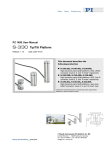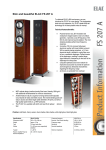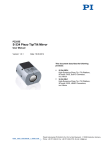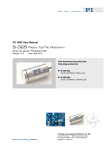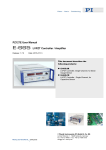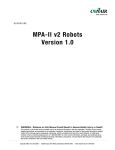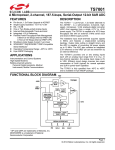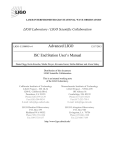Download Artisan Technology Group is your source for quality new and
Transcript
Artisan Technology Group is your source for quality new and certified-used/pre-owned equipment • FAST SHIPPING AND DELIVERY • TENS OF THOUSANDS OF IN-STOCK ITEMS • EQUIPMENT DEMOS • HUNDREDS OF MANUFACTURERS SUPPORTED • LEASING/MONTHLY RENTALS • ITAR CERTIFIED SECURE ASSET SOLUTIONS SERVICE CENTER REPAIRS Experienced engineers and technicians on staff at our full-service, in-house repair center WE BUY USED EQUIPMENT Sell your excess, underutilized, and idle used equipment We also offer credit for buy-backs and trade-ins www.artisantg.com/WeBuyEquipment InstraView REMOTE INSPECTION LOOKING FOR MORE INFORMATION? Visit us on the web at www.artisantg.com for more information on price quotations, drivers, technical specifications, manuals, and documentation SM Remotely inspect equipment before purchasing with our interactive website at www.instraview.com Contact us: (888) 88-SOURCE | [email protected] | www.artisantg.com PZ 107E User Manual S-330 Tip/Tilt Platform Release: 1.1.1 Date: 2003-09-09 This document describes the following product(s): S-330.10 Piezo Tip/Tilt Platform, ±1 mrad, Closed-Loop S-330.P10 Piezo Tip/Tilt Platform, ±1 mrad, Closed-Loop with PICMA Ceramic S-330.30 Piezo Tip/Tilt Platform, ±1 mrad © Physik Instrumente (PI) GmbH & Co. KG Auf der Römerstr. 1 76228 Karlsruhe, Germany Tel. +49-721-4846-0 Fax: +49-721-4846-299 [email protected] www.pi.ws Artisan Technology Group - Quality Instrumentation ... Guaranteed | (888) 88-SOURCE | www.artisantg.com S-330 XY Tip/Tilt Platform User Manual PZ 107E Table of Contents : 0 1 2 3 Manufacturer Declarations ................................................................. 2 0.1 Quality and Warranty Clauses................................................................. 2 0.2 Safety Precautions .................................................................................. 2 Introduction.......................................................................................... 3 1.1 Features .................................................................................................. 3 1.2 Design ..................................................................................................... 3 1.3 Models Available ..................................................................................... 3 Quick Start ........................................................................................... 4 2.1 Mounting.................................................................................................. 4 2.2 Connecting to Controller and Starting ..................................................... 4 Working Principle ................................................................................ 5 3.1 Operating Voltages.................................................................................. 5 3.2 Motion Polarities ...................................................................................... 6 3.3 Position Sensors...................................................................................... 7 4 Drive Electronics ................................................................................. 8 5 Dynamic Behavior ............................................................................... 9 6 S-330 Technical Data......................................................................... 10 6.1 Connectors ............................................................................................ 11 6.2 Dimensions............................................................................................ 11 © Copyright 1997-2004 by Physik Instrumente (PI) GmbH& Co. KG Release: 1.1.1 File:S-330UserPZ107E111.doc, 244736 Bytes Release 1.1.1 www.pi.ws Page 1 Artisan Technology Group - Quality Instrumentation ... Guaranteed | (888) 88-SOURCE | www.artisantg.com S-330 XY Tip/Tilt Platform 0 0.1 User Manual PZ 107E Manufacturer Declarations Quality and Warranty Clauses Certification Physik Instrumente GmbH & Co. KG (PI) certifies that this product met its published specifications at the time of shipment. The device was calibrated and tested before shipment. Warranty This Physik Instrumente product is warranted against defects in materials and workmanship for a period of one year from date of shipment. Duration and conditions of warranty for this product may be superseded when the product is integrated into (becomes a part of) other Physik Instrumente products. During the warranty period, Physik Instrumente will, at its option, either repair or replace products which prove to be defective. Limitation of Warranty The foregoing warranty shall not apply to defects resulting from improper or inadequate maintenance by the Buyer, Buyer supplied products or interfacing, unauthorised modification or misuse, operation outside of the environmental specifications for the product, or improper site preparation or maintenance. The design and connection of any circuitry to this product is the sole responsibility of the Buyer. PI does not warrant the Buyer's circuitry or malfunctions of PI products that result from the Buyer's circuitry. In addition, PI does not warrant any damage that occurs as a result of the Buyer's circuit or any defects that result from Buyer-supplied products. No other warranty is expressed or implied. Physik Instrumente specifically disclaims the implied warranties of merchantability and fitness for a particular purpose. 0.2 Safety Precautions Warning: Be careful when mounting the platform Never use the hole on the platforms surface for mounting an object. Never put anything in the flexure gaps of the body. Do not clamp the body since this can block the flexure guiding system. Warning: Resonance Can Cause Permanent Damage The system must never be operated close to the resonant frequency or permanent damage can result. If you hear or see resonant behavior, switch off the unit immediately. Release 1.1.1 www.pi.ws Page 2 Artisan Technology Group - Quality Instrumentation ... Guaranteed | (888) 88-SOURCE | www.artisantg.com S-330 XY Tip/Tilt Platform 1 User Manual PZ 107E Introduction The S-330 tip/tilt platform is an active tip/tilt stage system based on the differentialpiezo-drive design incorporating two pairs of LVPZT (low voltage piezoelectric translator) actuators. The system is designed for fast and precise laser beam steering in two axes and for stabilizing and correcting optical axes or paths. 1.1 Features ¾ Sub-µrad Resolution ¾ For Mirrors to 50 mm ¾ Closed-Loop Versions ¾ Differential Design for Excellent Temperature Stability Fig. 1. S-330 tip/tilt mirror 1.2 Design The tip/tilt platform is mounted on four LVPZT stacks, located at the corners of a square. Tilting around one axis requires synchronized movement of two diagonally opposite LVPZT actuators. To ensure that one actuator will contract by exactly the same amount as the other expands, the actuator pairs are individually matched at the factory. The actuators in each pair are then connected electrically in differential push-pull mode, eliminating Z-axis freedom. Note that with this design the pivot point is fixed and the same for both rotation axes. Whether you choose to measure the angles in vertical planes or in planes perpendicular to the platform depends on the requirements of your application. 1.3 Models Available S-330.10 PZT Tip/Tilt Platform, 2 Axes, ±1 mrad, Closed-Loop S-330.P10 same as S-330.10 but with PICMA ceramic actuator S-330.30 PZT Tip/Tilt Platform, 2 Axes, ±1 mrad, Open-Loop Release 1.1.1 www.pi.ws Page 3 Artisan Technology Group - Quality Instrumentation ... Guaranteed | (888) 88-SOURCE | www.artisantg.com S-330 XY Tip/Tilt Platform 2 2.1 User Manual PZ 107E Quick Start Mounting You can mount the object to be positioned (for example, a mirror) on the platform using glue. Warnings Never use the hole on the platform surface for mounting an object. Never put anything in or across the gaps (flexure guiding system) of the body. Do not clamp the body since this can block the flexure guiding system. The platform can be mounted in any orientation. If you mount it on a vertical plane, however, the maximum “sideways” force limitation of 1 N will limit the load capacity accordingly. By default, the platform metal case is not connected electrically. You should ground the mechanics if so required. 2.2 Connecting to Controller and Starting The following instructions describe starting the S-330 tip/tilt platform using PI’s E500-series control electronics (E-500 or E-501 chassis including E-503.00S amplifier module and, when using the closed-loop model, E-509.S3S servo-control module). If you use other modules from the E-500 series the steps are the same, but the connections details may differ. In this case please consult “Drive Electronics” Section on p. 8 for further information. 1. Make sure the control electronics is switched off. 2. Closed-loop models (S-330.10 and S-330.P10) only: Connect the S-330 tip/tilt mirror to the E-509.S3S servo-control module. The sensor cable of the S-330, which has a 4-pin connector and is labeled “CH1”, must be plugged into the corresponding socket of the servo-control module (labeled “SERVO 1”). This cable carries sensor signals from channels 1 and 2. 3. Connect the S-330 tip/tilt platform to the E-503.00S amplifier module. The supply voltage cables of the S-330 have brown connectors and are labeled “CH 1”, “CH 2” and “CH 3”. They must be plugged into the corresponding output sockets of the amplifier module. Note: Do not mix up the cables while connecting, since the amplifier channels are connected internally so as to supply the platform channels 1 and 2 with variable drive signals, while channel 3 is supplied with a constant and very stable voltage of +100 volts. Warning: Resonance Can Cause Permanent Damage The system must never be operated close to the resonant frequency or permanent damage can result. If you hear or see resonant behavior, switch off the unit immediately. See “Dynamic Behavior” Section on p. 9 for more details. 4. Switch on the control electronics. Consult the E-500 User Manual, and, if you have an E-516 interface module installed, the E-516 E-User Manual for information on commanding the S-330 tip/tilt platform. If Release 1.1.1 www.pi.ws Page 4 Artisan Technology Group - Quality Instrumentation ... Guaranteed | (888) 88-SOURCE | www.artisantg.com S-330 XY Tip/Tilt Platform User Manual PZ 107E you have the closed-loop model, see also the User Manual of the servo-control module (E-509) for details on servo-control settings. 3 Working Principle The S-330 contains two pairs of PZT actuators. The actuators in each pair are connected in differential push-pull mode: any change in the operating voltage causes one actuator of the pair to see a voltage increase, the other to see a decrease of the exact same magnitude. Because the symmetrical design of the tip/tilt platform system, temperature changes will not effect the angular orientation but only the Z-axis position (axial thermal drift). Most applications are much less sensitive to this kind of instability as long as the angular orientation remains stable. Dwg# s330_1.tif Fig. 2. S-330 Differential-drive tip/tilt platform, working principle (only Axis-1 tip motion shown) 3.1 Operating Voltages Each tilt axis of the tip/tilt platform system requires one controlled operating voltage in the range of 0 to +100 volts and one constant voltage of +100 V. At the zero position (tilt angle zero) both actuators of a pair are expanded to 50% of their maximum expansion (i.e. to 7.5 µm). Control voltages below 50 volts cause tilting in one direction, above 50 volts, tilting in the other. A 0 to 10 V control input thus covers the full tilt range. Operation over an extended range of -20 to +120 V is possible with certain limitations. Release 1.1.1 www.pi.ws Page 5 Artisan Technology Group - Quality Instrumentation ... Guaranteed | (888) 88-SOURCE | www.artisantg.com S-330 XY Tip/Tilt Platform 3.2 User Manual PZ 107E Motion Polarities The diagram below shows the relative positions of the four PZT stacks and makes the relative rotation polarities clear. Dwg#: S330_layout.tif Fig. 3. S-330 viewed from above with Axis 1 (controlled by channel 1) running left and right. Keeping in mind that the grounded PZTs expand with increasing input, it can be seen that if after a positive Axis 1 tilt, you look “uphill” across the platform, a subsequent positive Axis 2 tilt would go up to the left and down to the right. Conversely, facing “uphill” after a positive Axis 2 tilt, a positive Axis 1 tilt would go down to the left and up to the right. The “handedness” of an open-loop system (with no sensor cable) can thus be inverted by interchanging the axes and rotating the unit 90°. Release 1.1.1 www.pi.ws Page 6 Artisan Technology Group - Quality Instrumentation ... Guaranteed | (888) 88-SOURCE | www.artisantg.com S-330 XY Tip/Tilt Platform 3.3 User Manual PZ 107E Position Sensors The closed-loop versions, S-330.10 and S-330.P10, are equipped with two pairs of strain gauge position feedback sensors operated in a bridge circuit for ultra-high resolution and angular stability. These sensors permit angular movements to be executed with sub-µrad resolution and repeatability. The S-330.10 and S-330.P10 use strain gauge sensors in a half-bridge configuration. 4 SGS on 4 PZTs 2 sensor channels on 1 LEMO connector Fig. 4. S-330 sensor cable connections and pinout. X1, Y1,... refer to the PZT on which the respective sensors are mounted (see Fig. 3) Note that both sensor channels are routed over a single sensor connector. If using an E-509.S3S controller, connect this cable to the CH1 socket. The CH2 and CH3 sockets are not connected. Release 1.1.1 www.pi.ws Page 7 Artisan Technology Group - Quality Instrumentation ... Guaranteed | (888) 88-SOURCE | www.artisantg.com S-330 XY Tip/Tilt Platform 4 User Manual PZ 107E Drive Electronics The S-330 tip/tilt platform system can be controlled by electronics of the E-500 series: Amplifier (choice of the following, always required): E-503.00S Amplifier module special connected for differential-drive LVPZT tip/tilt platforms; 2 channels with variable drive signals (output sockets “CH1” and “CH2”) plus 100 V fixed output (output socket “CH3”) 2 x E-505.00 1 x E-505.00S Single Channel modules. With two E-505.00 modules on the left and one E-505.00S on the right, “CH1” of the platform must be connected to the leftmost module, “CH2” to the center module and “CH3” to the E-505.00S Note: On amplifiers for tip/tilt mirrors, the DC-offset potentiometer for channel 3, if present at all, is disabled and the output is clamped internally to +100 volts. The analog input of this channel is also disabled. External control voltages thus must be supplied to the CONTROL INPUT sockets of CH1 and CH2. Controller (required in addition to amplifier for closed-loop operation): E-509.S3S Position servo-control module for SGS sensors; channel 1 (labeled “SERVO 1”) must be used with the platforms sensor cable, second and third channel (input sockets “SERVO 2” and “SERVO 3”) are not used. Note: This controller has the same front panel as a regular 3-channel version, but with the CH3 controls/connections deactivated and sensor channels 1 and 2 both routed through the CH1 sensor socket. Display Module (displays position or voltage of axes, not required): E-515.03 3½-digit LED position or voltage display for each of 3 channels (channel 3 not used) E-515.01 3½-digit LED position or voltage display, 1 channel (2 modules needed for 2-axis display) Computer Interface and Display Module (replaces display above, required for computer-controlled operation): E-516.i3* Computer Interface and Display Module, 3 channels, (channel 3 not used) *The discontinued E-515.i3 can also be used. Release 1.1.1 www.pi.ws Page 8 Artisan Technology Group - Quality Instrumentation ... Guaranteed | (888) 88-SOURCE | www.artisantg.com S-330 XY Tip/Tilt Platform 5 User Manual PZ 107E Dynamic Behavior In addition to the amplifier, controller and sensor bandwidths, the maximum operating frequency of a tilt platform depends on its mechanical resonant frequency. To estimate the effective resonant frequency of the tilt mirror system (platform + mirror), the moment of inertia of the mirror substrate must first be calculated. Moment of inertia of a rotationally symmetric mirror: Im 2 ª 3R 2 H 2 § H · º m« ¨ T » 12 ©2 ¹̧ ¼» ¬« Moment of inertia of a rectangular mirror: Im 2 ª L2 H 2 § H · º m« ¨ T » ©2 ¹̧ »¼ «¬ 12 where: m = Mirror mass [g] IM = Moment of inertia of the mirror [g·mm2] L =Mirror length perpendicular to the tilt axis [mm] H = Mirror thickness [mm] T = Distance, pivot point to platform surface (see technical data table for individual model) [mm] R = Mirror radius [mm] Using the resonant frequency of the unloaded platform (see Technical Data table) and the moment of inertia of the mirror substrate, the system resonant frequency is calculated according to the following equation: Resonant frequency of a tilt platform / mirror system: f' f0 1 IM I0 where: f' = Resonant frequency of platform with mirror [Hz] f0 = Resonant frequency of unloaded platform [Hz] I0 = Moment of inertia of the platform (see technical data table) [g·mm2] IM= Moment of inertia of the mirror [g·mm2] For more information on static and dynamic behavior of piezo actuators, see the "Tutorial" section of the PI Catalog, in particular pages 4-27 ff. Release 1.1.1 www.pi.ws Page 9 Artisan Technology Group - Quality Instrumentation ... Guaranteed | (888) 88-SOURCE | www.artisantg.com S-330 XY Tip/Tilt Platform 6 User Manual PZ 107E S-330 Technical Data Models Active axes (fixed orthogonal tilt axes) Tip/tilt range 0 to 100 V1 Closed-loop tilt angle Integrated feedback sensor Open-loop / closed-loop resolution2 Closed-loop linearity (typ.) Full-range repeatability (typ.) 3 Electrical capacitance4 Dynamic operating current coefficient (DOCC) 5 Resonant frequency (f0) without mirror6 Resonant frequency w/ Ø 25 x 8 mm glass mirror7 Distance, pivot point to platform surface Platform moment of inertia Operating temperature range8 Voltage connection Sensor connection Weight (w/o cables) Material PICMA ceramic actuator9 S-330.30 (open-loop) 2 ±1 – – 0.05 – – 3.6 per axis 0.22 per axis 3.3 2.4 6 1530 -20 to 80 3 x Lemo fem. 2m cable – 200 Stainless steel case, Invar platform no S-330.10 / S-330.P10 Units (closed-loop) 2 ±1 mrad ±20% ±1 mrad 4 x strain gauge 0.1 µrad ±0.2 % ±2 µrad 3.6 per axis µF ±20% 0.22 per axis µA/(Hz x µrad) 3.3 kHz ±20% 2.4 kHz ±20% 6 1530 -20 to 80 3 x Lemo fem. 2m cable 1 x Lemo, 2m cable 200 Stainless steel case, Invar platform mm g·mm2 °C g ±5% no / yes Notes: 1 2 3 4 5 6 7 8 9 Range: Operation over a -20 to +120 V range is possible if excursions to the limits are of short duration. See “Lifetime of PZTs” in the PI Catalog for more information. Special open-loop version with ± 2.5 mrad for 0-100 V is available on request. Resolution of PZT tip/tilt platforms is not limited by friction or stiction. Value is typical (RMS, 1ı) noise-equivalent motion with E-503 amplifier module. Full-Range Repeatability: Typical values, closed-loop mode. Since repeatability is a percentage of angle traveled, repeatability is significantly better for small ranges. Temperature Range: Small-signal value (measured at 1 V, 1000 Hz, 20°C, no load); largesignal values at room temperature are 30 to 50% higher. The capacitance of PZT ceramics changes with amplitude, temperature, and load up to 200% of the unloaded, small-signal capacitance at room temperature. For detailed information on power requirements, refer to the amplifier frequency response curves in the "PZT Control Electronics" section of the PI Catalog. Dynamic Operating Current Coefficient in µA per hertz and µrad. Example: Sinusoidal scan of 100 µrad at 10 Hz requires approximately 0.22 mA drive current. Unloaded Resonant Frequency: Lowest tilt resonant frequency around an active axis without mirror (well above the maximum operating frequency). For more resonance considerations, see p. 4-28 in the PI Catalog. Resonant Frequency with Mirror: Example of how a load (mirror) affects the (calculated) resonant frequency. Standard range, other temperature ranges on request. Closed-loop systems are calibrated for optimum performance at room temperature. Recalibration is recommended if operation is at a significantly higher or lower temperature. PICMA™ ceramics offer extended lifetime and compatibility with harsh conditions. Release 1.1.1 www.pi.ws Page 10 Artisan Technology Group - Quality Instrumentation ... Guaranteed | (888) 88-SOURCE | www.artisantg.com S-330 XY Tip/Tilt Platform 6.1 User Manual PZ 107E Connectors The S-330 tip/tilt platform is equipped with three cables for supply voltage and and one cable for the sensor signals. Its LEMO connectors match the amplifier and servo controller modules. The supply voltage cables of the S-330.xx are labeled “CH 1”, “CH 2” and “CH 3”. The sensor cable of the S-330.10 and S-330.P10 (with 4-pin connector) is labeled “CH 1”. It carries sensor signals for both channels 1 and 2 (see Section 3.3, p. 7) 6.2 Dimensions S-330 dimensions in mm, decimal places separated by a comma in drawings Note: On the open-loop model (S-330.30) the unused sensor cable outlet is plugged with silicon. Release 1.1.1 www.pi.ws Page 11 Artisan Technology Group - Quality Instrumentation ... Guaranteed | (888) 88-SOURCE | www.artisantg.com PZ 149E User Manual S-330 Tip/Tilt Platform Release: 1.1.0 Date: 2007-07-24 This document describes the following product(s): S-330.2SL, S-330.4SL, S-330.8SL High-dynamics piezo tip/tilt platforms, SGS, LEMO connector, travel 2, 5, and 10 mrad* respectively S-330.2SD, S-330.4SD, S-330.8SD High-dynamics piezo tip/tilt platforms, SGS, Sub-D connector, travel 2, 5, and 10 mrad* respectively S-330.20L, S-330.40L, S-330.80L High-dynamics piezo tip/tilt platforms, open-loop, LEMO connector, travel 2, 5, and 10 mrad* resp. *Values are mechanical travel in closed-loop mode; optical beam deflection is twice mechanical travel © Physik Instrumente (PI) GmbH & Co. KG Auf der Römerstr. 1 76228 Karlsruhe, Germany Tel. +49-721-4846-0 Fax: +49-721-4846-299 [email protected] www.pi.ws Artisan Technology Group - Quality Instrumentation ... Guaranteed | (888) 88-SOURCE | www.artisantg.com Declaration of Conformity according to ISO / IEC Guide 22 and EN 45014 Manufacturer: Manufacturer´s Address: Physik Instrumente (PI) GmbH & Co. KG Auf der Römerstrasse 1 D-76228 Karlsruhe, Germany The manufacturer hereby declares that the product, Product Name: Model Numbers: Product Options: Tip/Tilt Platform S-330 all when operated with a complying controller from PI, complies with the following European directives: 73/23/EWG, Niederspannungsrichtlinie / 73/23/EEC, Low voltage directive 89/336/EWG, EMV- Richtlinie / 89/336/EEC, EMC-Directive 98/37/EG, Maschinenrichtlinie / 98/37/EC, Machinery Directive The applied standards certifying the conformity are listed below. Electromagnetic Emission: EN 61000-6-3, EN 55011 Electromagnetic Immunity: EN 61000-6-1 Safety (Low Voltage Directive) : EN 61010-1 Safety of Machinery: EN 12100 15 July, 2007 Karlsruhe, Germany Dr. Karl Spanner President Artisan Technology Group - Quality Instrumentation ... Guaranteed | (888) 88-SOURCE | www.artisantg.com Copyright 1999–2007 by Physik Instrumente (PI) GmbH & Co. KG, Karlsruhe, Germany. The text, photographs and drawings in this manual enjoy copyright protection. With regard thereto, Physik Instrumente (PI) GmbH & Co. KG reserves all rights. Use of said text, photographs and drawings is permitted only in part and only upon citation of the source First printing 2007-07-24 Document Number PZ 149E, Release 1.1.0 S-330_User_PZ149E110.doc This manual has been provided for information only and product specifications are subject to change without notice. Artisan Technology Group - Quality Instrumentation ... Guaranteed | (888) 88-SOURCE | www.artisantg.com About This Document Users of This Manual This manual is designed to help the reader to install and operate the S-330 Tip/Tilt Platform. It assumes that the reader has a fundamental understanding of basic servo systems, as well as motion control concepts and applicable safety procedures. The manual describes the physical specifications and dimensions of S-330 Tip/Tilt Platforms as well as the software and hardware installation procedures which are required to put the associated motion system into operation. Updated releases are available for download from www.pi.ws.or email: contact your PI Sales Engineer or write [email protected]. Conventions The notes and symbols used in this manual have the following meanings: WARNING Calls attention to a procedure, practice or condition which, if not correctly performed or adhered to, could result in injury or death. CAUTION Calls attention to a procedure, practice, or condition which, if not correctly performed or adhered to, could result in damage to equipment. NOTE Provides additional information or application hints. Related Documents The motion controller and the software tools which may be delivered with S-330 Tip/Tilt Platform are described in their own manuals. Updated releases are available for download from www.pi.ws.or email: contact your PI Sales Engineer or write [email protected]. Artisan Technology Group - Quality Instrumentation ... Guaranteed | (888) 88-SOURCE | www.artisantg.com ! Contents 1 Introduction 1.1 1.2 1.3 1.4 1.5 1.6 1.7 2 3 9 Design ........................................................................................9 Operating Voltages...................................................................10 Motion Polarities.......................................................................10 Drive Electronics 4.1 4.2 6 Mounting ....................................................................................6 Connecting to Controller and Starting ........................................6 Working Principle 3.1 3.2 3.3 4 Features .....................................................................................2 Parallel Kinematics.....................................................................2 Operation ...................................................................................3 Superior Lifetime ........................................................................3 Models Available ........................................................................4 Safety Precautions .....................................................................4 Prescribed Use...........................................................................5 Quick Start 2.1 2.2 2 12 Sub-D-Connector Versions (S-330.xxD) ..................................12 LEMO-Connector Versions (S-330.xxL)...................................12 5 Dynamic Behavior 14 6 Old Equipment Disposal 15 7 Technical Data 16 7.1 Connectors ...............................................................................18 7.1.1 7.1.2 7.2 Sub-D Versions ........................................................................ 18 LEMO Versions ........................................................................ 19 Dimensions ..............................................................................20 Artisan Technology Group - Quality Instrumentation ... Guaranteed | (888) 88-SOURCE | www.artisantg.com Introduction 1 Introduction S-330 piezo platforms are fast and compact tip/tilt units providing precise angular motion of the top platform around two coplanar, orthogonal axes. These flexure-guided platforms can provide high accelerations, enabling step response times in the sub-millisecond range. On closed-loop versions, high-resolution, absolute measuring strain gauge sensors (SGS) are applied to appropriate places on the drive train and feed the platform position information back to a piezoelectric controller. The sensors are connected in a full-bridge configuration to eliminate thermal drift; they assure optimal position stability and rapid response with nanometer resolution. Both open- and closed-loop versions in 3 different tilt ranges up to 10 mrad (20 mrad optical deflection) are available. 1.1 Features Resolution to 20 nrad, Excellent Position Stability Coplanar Rotation Axes, Single Moving Platform Optical Beam Deflection to 20 mrad (>1°) 1.2 Higher Dynamics, Stability & Linearity Through ParallelKinematics Design Sub-Millisecond Response For Mirrors up to 50 mm Diameter Closed-Loop Versions for Better Linearity Excellent Temperature Stability Parallel Kinematics These PI piezo tip/tilt platforms are based on a parallelkinematics design with coplanar rotational axes and a single moving platform driven by two pairs of differential actuators. The advantage is jitter-free, multi-axis motion with excellent temperature stability. The single pivot-point design also avoids the drawback of polarization rotation, common with stacked systems like galvo-scanners. www.pi.ws S-330 PZ 149E Release 1.1.0 Page 2 Artisan Technology Group - Quality Instrumentation ... Guaranteed | (888) 88-SOURCE | www.artisantg.com Introduction 1.3 Operation S-330 tip/tilt platforms must be operated in conjunction with three highly stable piezo amplifiers, and the closed-loop versions with electronics including a servo-controller for each motion axis. See Section 4 “Drive Electronics” for more information. The electronics can in general be controlled in a number of different ways, including manual control (via 10-turn potentiometers), low-voltage control signals (perhaps from a DAQ-board in a PC), or convenient high-level ASCII commands from a host PC. See the documentation of the electronics for more details. All electronics, including analog controllers, have comprehensive software available, and all documentation can be freely downloaded from www.pi.ws. 1.4 Superior Lifetime Highest possible reliability is assured by the use of awardwinning PICMA® multilayer piezo actuators. PICMA® actuators are the only ceramic encapsulated actuators on the market, which makes them uniquely resistant to ambient humidity and leakage-current failures. They are thus far superior to conventional actuators in reliability and lifetime. Fig. 1: S-330.2SL, S-330.4SL and S-330.8SL tip/tilt platforms www.pi.ws S-330 PZ 149E Release 1.1.0 Page 3 Artisan Technology Group - Quality Instrumentation ... Guaranteed | (888) 88-SOURCE | www.artisantg.com Introduction 1.5 Models Available Travel ranges in parentheses are optical beam deflection angles and are thus twice the mechanical tip/tilt value. High-dynamics piezo tip/tilt platform, 2 (4) mrad, SGS, LEMO Connector S-330.2SD High-dynamics piezo tip/tilt platform, 2 (4) mrad, SGS, Sub-D Connector S-330.20L High-dynamics piezo tip/tilt platform, 2 (4) mrad, Open-Loop, LEMO Connector S-330.4SL High-dynamics piezo tip/tilt platform, 5 (10) mrad, SGS, LEMO Connector S-330.4SD High-dynamics piezo tip/tilt platform, 5 (10) mrad, SGS, Sub-D Connector S-330.40L High-dynamics piezo tip/tilt platform, 5 (10) mrad, Open-Loop, LEMO Connector S-330.8SL High-dynamics piezo tip/tilt platform, 10 (20) mrad, SGS, LEMO Connector S-330.8SD High-dynamics piezo tip/tilt platform, 10 (20) mrad, SGS, Sub-D Connector S-330.80L High-dynamics piezo tip/tilt platform, 10 (20) mrad, Open-Loop, LEMO Connector S-330.2SL 1.6 Safety Precautions CAUTION ! Be careful when mounting Never use the hole on the platform’s surface for mounting an object. Never put anything in the flexure gaps of the body. Do not clamp the body since this can block the flexure guiding system. Calibrated System If you purchased a motion system consisting of tip/tilt platform and controller, do not interchange parts or channels; they are matched and calibrated together. Respect the assignment of the platform’s supply voltage and sensor channels to the individual controller channels, as indicated by the serial numbers on the labels affixed to the devices. www.pi.ws S-330 PZ 149E Release 1.1.0 Page 4 Artisan Technology Group - Quality Instrumentation ... Guaranteed | (888) 88-SOURCE | www.artisantg.com Introduction Resonance Can Cause Permanent Damage The system must never be operated close to the resonant frequency or permanent damage can result. If you hear or see resonant behavior, switch off the unit immediately. 1.7 Prescribed Use Based on its design and realization, the S-330 Tip/Tilt Platform is intended precision positioning of small payloads about two rotation axes when connected to a compatible PI piezo motion controller. It is a laboratory apparatus as defined by DIN EN 61010 and meets the following minimum specifications for safe operation (any more stringent specifications in the technical data table, p. 16, e.g. operating temperature -20°C to 80°C, are of course, also met): www.pi.ws Indoor use only Altitude up to 2000 m Temperature range 5°C to 40°C Max. relative humidity 80% for temperatures up to 31°C, decreasing linearly to 50% relative humidity at 40°C S-330 PZ 149E Release 1.1.0 Page 5 Artisan Technology Group - Quality Instrumentation ... Guaranteed | (888) 88-SOURCE | www.artisantg.com Quick Start 2 Quick Start 2.1 Mounting You can mount the object to be positioned (for example, a mirror) on the platform using glue. CAUTION Never use the hole on the platform surface for mounting an object. Never put anything in or across the gaps (flexure guiding system) of the body. Do not clamp the body since this can block the flexure guiding system. The platform can be mounted in any orientation. If you mount it on a vertical plane, however, the maximum “sideways” force limitation of 1 N will limit the load capacity accordingly. By default, the platform metal case is not connected electrically. You should ground the mechanics if so required. 2.2 Connecting to Controller and Starting The following instructions describe starting the S-330 tip/tilt platform using PI’s E-500-series control electronics (E-500 or E501 chassis including either an E-616 amplifier/controller or an E-503.00S amplifier module and, when using the closed-loop model, an E-509.S3 servo-control module). If you use other modules from the E-500 series the steps are the same, but the connections details may differ. In this case please consult “Drive Electronics” Section on p. 12 for further information. www.pi.ws S-330 PZ 149E Release 1.1.0 Page 6 Artisan Technology Group - Quality Instrumentation ... Guaranteed | (888) 88-SOURCE | www.artisantg.com ! Quick Start CAUTION ! Calibrated System If you purchased a motion system consisting of tip/tilt platform and controller, do not interchange parts or channels; they are matched and calibrated together. Respect the assignment of the platform’s supply voltage and sensor channels to the individual controller channels, as indicated by the serial numbers on the labels affixed to the devices. Resonance Can Cause Permanent Damage The system must never be operated close to the resonant frequency or permanent damage can result. If you hear or see resonant behavior, switch off the unit immediately. See “Dynamic Behavior” Section on p. 14 for more details. 1 Make sure the control electronics is switched off. 2 Closed-loop, sub-D-connector models (S-330.xSD): Connect the sub-D connector to the PZT+Sensor socket of the control electronics and go to Step 4. 3 LEMO-connector models (S-330.xxL): a) Connect the drive cables from the S-330 tip/tilt platform to the E-503.00S amplifier module. The drive voltage cables have brown connectors and are labeled “CH 1”, “CH 2” and “CH 3”. They must be plugged into the corresponding output sockets of the amplifier module. NOTE Do not mix up the cables while connecting, since the amplifier channels are connected internally so as to supply the platform channels 1 and 2 with variable drive signals, while channel 3 is supplied with a constant and very stable voltage of +100 volts. www.pi.ws S-330 PZ 149E Release 1.1.0 Page 7 Artisan Technology Group - Quality Instrumentation ... Guaranteed | (888) 88-SOURCE | www.artisantg.com Quick Start b) Closed-loop models (S-330.xSL) only: Connect the sensor cables from the tip/tilt platform to the E509.S3 servo-control module. The two sensor cables with 4-pin connectors labeled “CH1” and "CH2" must be plugged into the corresponding sockets of the servo-control module (labeled “SERVO 1” and "SERVO 2"). 4 www.pi.ws Switch on the control electronics. Consult the E-500 User Manual, and, if you have an E516 or E-616 module installed, the corresponding User Manual for information on commanding the S-330 tip/tilt platform. If you have and E-509 servo-control module, consult also its User Manual. S-330 PZ 149E Release 1.1.0 Page 8 Artisan Technology Group - Quality Instrumentation ... Guaranteed | (888) 88-SOURCE | www.artisantg.com Working Principle 3 Working Principle 3.1 Design The tip/tilt platform is mounted on four LVPZT stacks, located at the corners of a square. Tilting around one axis requires synchronized movement of two diagonally opposite LVPZT actuators. To ensure that one actuator will contract by exactly the same amount as the other expands, the actuator pairs are individually matched at the factory. The actuators in each pair are then connected electrically in differential push-pull mode, eliminating Z-axis freedom. NOTE With this design the pivot point is fixed and the same for both rotation axes. Whether you choose to measure the angles in vertical planes or in planes perpendicular to the platform depends on the requirements of your application. Because the symmetrical design of the tip/tilt platform system, temperature changes will not effect the angular orientation but only the Z-axis position (axial thermal drift). Most applications are much less sensitive to this kind of instability as long as the angular orientation remains stable. The closed-loop versions are equipped with two pairs of strain gauge position feedback sensors operated in a bridge circuit for ultra-high resolution and angular stability. These sensors permit angular movements to be executed with sub-µrad resolution and repeatability. www.pi.ws S-330 PZ 149E Release 1.1.0 Page 9 Artisan Technology Group - Quality Instrumentation ... Guaranteed | (888) 88-SOURCE | www.artisantg.com Working Principle Fig. 2: S-330 Differential-drive tip/tilt platform, working principle (only Axis-1 tip motion shown) 3.2 Operating Voltages Each tilt axis of the tip/tilt platform system requires one controlled operating voltage in the range of 0 to +100 volts and one constant voltage of +100 V. At the zero position (tilt angle zero) both actuators of a pair are expanded to 50% of their maximum expansion (i.e. to 7.5 ȝm). Control voltages below 50 volts cause tilting in one direction, above 50 volts, tilting in the other. Operation over an extended range of -20 to +120 V is possible, but excursions above 100 V and below -20 V should be kept of short duration. 3.3 Motion Polarities The diagram below shows the relative positions of the four PZT stacks and makes the relative rotation polarities clear. www.pi.ws S-330 PZ 149E Release 1.1.0 Page 10 Artisan Technology Group - Quality Instrumentation ... Guaranteed | (888) 88-SOURCE | www.artisantg.com Working Principle Fig. 3 S-330 viewed from above with Axis 1 (controlled by channel 1) running left and right. Keeping in mind that the grounded PZTs expand with increasing input, it can be seen that if after a positive Axis 1 tilt, you look “uphill” across the platform, a subsequent positive Axis 2 tilt would go up to the left and down to the right. Conversely, facing “uphill” after a positive Axis 2 tilt, a positive Axis 1 tilt would go down to the left and up to the right. www.pi.ws S-330 PZ 149E Release 1.1.0 Page 11 Artisan Technology Group - Quality Instrumentation ... Guaranteed | (888) 88-SOURCE | www.artisantg.com Drive Electronics 4 Drive Electronics 4.1 Sub-D-Connector Versions (S-330.xxD) Versions with the sub-D connector can be connected directly to the E-616 Amplifier/Controller. 4.2 LEMO-Connector Versions (S-330.xxL) LEMO-connector versions can be controlled by the following combinations of E-500-series modules: Amplifier (choice of the following, always required): E-503.00S 2 x E-505.00 1 x E-505.00S Amplifier module special connected for differential-drive LVPZT tip/tilt platforms; 2 channels with variable drive signals (output sockets “CH1” and “CH2”) plus 100 V fixed output (output socket “CH3”) Single Channel modules. With two E-505.00 modules on the left and one E-505.00S on the right, “CH1” of the platform must be connected to the leftmost module, “CH2” to the center module and “CH3” to the E-505.00S NOTE On amplifiers for differential-drive tip/tilt mirrors, the DCoffset potentiometer for channel 3, if present at all, is disabled and the output is clamped internally to +100 volts. The analog input of this channel is also disabled. External control voltages thus must be supplied to the CONTROL INPUT sockets of CH1 and CH2. Controller (required in addition to amplifier for closed-loop operation): E-509.S3 www.pi.ws Position servo-control module for SGS sensors; channel 1 and 2 (labeled “SERVO 1” and "SERVO 2") must be used with the platforms sensor cables "CH1" and "CH2" accordingly S-330 PZ 149E Release 1.1.0 Page 12 Artisan Technology Group - Quality Instrumentation ... Guaranteed | (888) 88-SOURCE | www.artisantg.com Drive Electronics Display Module (displays position or voltage of axes, not required): E-515.03 E-515.01 3½-digit LED position or voltage display for each of 3 channels (channel 3 not used) 3½-digit LED position or voltage display, 1 channel (2 modules needed for 2-axis display) Computer Interface and Display Module (replaces display above, allows digital computer operation * ): E-516.i3 Computer Interface and Display Module, 3 channels, (channel 3 not used) * Computer-generated analog signals can, of course, be used to control any S-330, with or without an E-516. For certain National Instrument DAQ cards operating with LabVIEW in a PC, PI provides an Analog Driver Set which makes the high-level PI General Command Set available over an analog interface. See the controller documentation, which should include Technical Note E500T0011 with complete instructions and the password for downloading the Analog Drivers. They are under E-500 in the download section of www.pi.ws. The associated documentation is available without password. www.pi.ws S-330 PZ 149E Release 1.1.0 Page 13 Artisan Technology Group - Quality Instrumentation ... Guaranteed | (888) 88-SOURCE | www.artisantg.com Dynamic Behavior 5 Dynamic Behavior In addition to the amplifier, controller and sensor bandwidths, the maximum operating frequency of a tilt platform depends on its mechanical resonant frequency. To estimate the effective resonant frequency of the tilt mirror system (platform + mirror), the moment of inertia of the mirror substrate must first be calculated. 2 ª 3R 2 H 2 § H · º ¨ T » m« 12 ©2 ¹̧ »¼ ¬« Moment of inertia of a rotationally symmetric mirror: Im 2 ª L2 H 2 § H · º m« ¨ T » ¹̧ »¼ ©2 ¬« 12 Moment of inertia of a rectangular mirror: Im where: m = Mirror mass [g] = Moment of inertia of the mirror [g•mm2] IM L =Mirror length perpendicular to the tilt axis [mm] H = Mirror thickness [mm] T = Distance, pivot point to platform surface (see technical data table for individual model) [mm] R = Mirror radius [mm] Using the resonant frequency of the unloaded platform (see Technical Data table on p. 16) and the moment of inertia of the mirror substrate, the system resonant frequency is calculated according to the following equation: Resonant frequency of a tilt platform / mirror system: f' f0 1 IM I0 where: f' = Resonant frequency of platform with mirror [Hz] = Resonant frequency of unloaded platform [Hz] f0 I0 = Moment of inertia of the platform (see technical data table, p. 9) [g•mm2] = Moment of inertia of the mirror [g•mm2] IM For more information on static and dynamic behavior of piezo actuators, see the "Tutorial" section of the PI Catalog. www.pi.ws S-330 PZ 149E Release 1.1.0 Page 14 Artisan Technology Group - Quality Instrumentation ... Guaranteed | (888) 88-SOURCE | www.artisantg.com Old Equipment Disposal 6 Old Equipment Disposal In accordance with EU directive 2002 / 96 / EC (WEEE), as of 13 August 2005, electrical and electronic equipment may not be disposed of in the member states of the EU mixed with other wastes. To meet the manufacturer’s product responsibility with regard to this product, Physik Instrumente (PI) GmbH & Co. KG will ensure environmentally correct disposal of old PI equipment that was first put into circulation after 13 August 2005, free of charge. If you have such old equipment from PI, you can send it to the following address postage-free: Physik Instrumente (PI) GmbH & Co. KG Auf der Römerstr. 1 76228 Karlsruhe, Germany www.pi.ws S-330 PZ 149E Release 1.1.0 Page 15 Artisan Technology Group - Quality Instrumentation ... Guaranteed | (888) 88-SOURCE | www.artisantg.com Artisan Technology Group - Quality Instrumentation ... Guaranteed | (888) 88-SOURCE | www.artisantg.com 7 șX , ș Y șX , ș Y Active axes see SL version Open-loop angular resolution in șX, șY 4 12.5 per axis Electrical Capacitance www.pi.ws Dynamic operating current coefficient (DOCC) PICMA Ceramic type ® 3.1 1 0.5 0.2 10 15 4x SGS șX , ș Y S-330.8SL ® 6 per axis PICMA 1530 6 ® 12.5 per axis PICMA 1530 6 S-330 PZ 149E Release 1.1.0 0.22 per axis 3 per axis PICMA 1530 Inertia, of mirror Drive properties 6 1530 3.3 0.5 0.25 0.1 5 7 4x SGS șX , ș Y S-330.4SL see SL version see SL version see SL version see SL version see SL version see SL version 4x SGS șX , ș Y S-330.2SD S-330.4SD S-330.8SD ® 12.5 per axis PICMA 1530 6 2.6 (with glass mirror, 1.6 (with glass mirror, 1.0 (with glass mirror, see SL version 25 mm diam., 8 mm 25 mm diam., 8 mm 25 mm diam., 8 mm thick) thick) thick) 3.7 Distance, pivot point to platform surface 6 ® see SL version Resonant frequency under load in șX and șY 6 see SL version Unloaded resonant frequnency in șX, șY Mechanical properties 5 0.15 - Repeatability in șX, șY 2 0.05 0.02 1 Closed-loop angular resolution in șX, șY - 1 - Closed-loop tilt angle șX, șY 2 3.5 see SL version Open-loop tilt angles for -20 to +120 V 8 4x SGS - Integrated sensor Motion and positioning S-330.2SL S-330.20L S-330.40L S-330.80L Models Technical Data Technical Data ±20% ±20% ±1 mm ±20% ±20% typ. typ. typ. min. µA ±20% Hz x mrad µF g x mm² mm Hz Hz µrad µrad µrad mrad mrad Page 16 Artisan Technology Group - Quality Instrumentation ... Guaranteed | (888) 88-SOURCE | www.artisantg.com see SL version 1.5 - 3x Lemo connector (low voltage) E-616: Mass Cable length Sensor connection Voltage connection Recommended controller / amplifier 10 mm 2 mm Mirror diameter Mirror thickness 3x Lemo connector (low voltage) 2x Lemo connector (SGS sensor) 1.5 0.38 Invar Stainless steel, nonmagnetic -20 to 80 S-330.4SL 3x Lemo connector (low voltage) 2x Lemo connector (SGS sensor) 1.5 0.7 Invar Stainless steel, nonmagnetic -20 to 80 S-330.8SL Sub-D connector, 25-pin Sub-D connector, 25-pin 1.5 see SL version Invar Stainless steel, nonmagnetic -20 to 80 S-330.2SD S-330.4SD S-330.8SD 2 mm 10 mm BK7, Ȝ/5, R > 98% (Ȝ = 500 nm to 2 µm) 2 mm 10 mm BK7, Ȝ/5, R > 98% (Ȝ = 500 nm bis 2 µm) 2 mm 10 mm BK7, Ȝ/5, R > 98% (Ȝ = 500 nm to 2 µm) 2 mm 10 mm BK7, Ȝ/5, R > 98% (Ȝ = 500 nm to 2 µm) E-500 modular control system E-501.00 chassis, E-503.00S amplifier, E-509.S3 servo-controller and optional E-516 interface module For high-dynamics applications with E-500.00 chassis and one E-505.00S and two E505.00 amplifiers 3x Lemo connector (low voltage) 2x Lemo connector (SGS sensor) 1.5 0.2 Invar Stainless steel, nonmagnetic -20 to 80 S-330.2SL mm mm m kg °C max. max. ±10 mm ±5% www.pi.ws S-330 PZ 149E Release 1.1.0 Page 17 1 Resolution of PZT tip/tilt platforms is not limited by friction or stiction. Value is typical (RMS, 1ı) noise-equivalent motion with E-503 amplifier module. 2 Full-Range Repeatability: Typical values, closed-loop mode. Since repeatability is a percentage of the angle traveled, repeatability is significantly better for small ranges. 3 Small-signal value (measured at 1 V, 1000 Hz, 20°C, no load); large-signal values at room temperature are 30 to 50% higher. The capacitance of PZT ceramics changes with amplitude, temperature, and load up to 200% of the unloaded, small-signal capacitance at room temperature. For detailed information on power requirements, refer to the amplifier frequency response curves in the "PZT Control Electronics" section of the PI Catalog. 4 Dynamic Operating Current Coefficient in µA per hertz and µrad. Example: Sinusoidal scan of 100 µrad at 10 Hz requires approximately 0.22 mA drive current. 5 Unloaded Resonant Frequency: Lowest tilt resonant frequency around an active axis without mirror (well above the maximum operating frequency). For more resonance considerations, see ”Tutorial” in the PI Catalog. 6 Resonant Frequency with Mirror: Example of how a load (mirror) affects the (calculated) resonant frequency. BK7, Ȝ/5, R > 98% (Ȝ = 500 nm to 2 µm) Standard mirror, mounted Mirror mounting Invar Platform material -20 to 80 Stainless steel, nonmagnetic 7 S-330.20L S-330.40L S-330.80L Material case Operating temperature range Miscellaneous Models Technical Data Technical Data 7 Standard range, other temperature ranges on request. Closed-loop systems are calibrated for optimum performance at room temperature. Recalibration is recommended if operation is at a significantly higher or lower temperature. 8 Mechanical tilt, optical beam deflection is twice as large. Special version with 10 mrad available on request. 7.1 Connectors 7.1.1 Sub-D Versions The S-330.xxD versions are equipped with a single sub-D25m plug carrying both the piezo voltages and the sensor signals. This connector interfaces directly with the E-616 Amplifier/Controller module. The pinout is as shown below: Pin Signal 1 14 SGS3-B1 SGS3-B2 2 15 Not used Not used 3 16 SGS2-B1 SGS2-B2 4 17 SGS-REF SGS-GND 5 18 SGS1-B1 SGS1-B2 6 19 SGS-REF SGS-GND 7 20 Connected to GND in plug* GAIN1 8 21 -15 V GAIN2 9 22 +15 V GAIN3 10 23 GND PZT1-GND 11 24 PZT1-OUT PZT2-GND 12 25 PZT2-OUT PZT3-GND 13 PZT3-OUT * Sensed by E-616, which then outputs a constant 100 V on PZT3-OUT www.pi.ws S-330 PZ 149E Release 1.1.0 Page 18 Artisan Technology Group - Quality Instrumentation ... Guaranteed | (888) 88-SOURCE | www.artisantg.com Technical Data 7.1.2 LEMO Versions The S-330.xxL versions are equipped with LEMO connectors for the individual piezo voltages and sensor signals, including a third piezo cable for the constant-voltage, 100 V, reference supply. The open-loop versions (S-330.x0L) have no sensor cables. The piezo supply voltage cables are labeled “CH 1”, “CH 2” and “CH 3”, whereby CH3 connects to the constant 100 V supply. The sensor cables (if present) have 4-pin connectors and are labeled “CH 1” and "CH2". Always connect the cables as labeled during calibration. www.pi.ws S-330 PZ 149E Release 1.1.0 Page 19 Artisan Technology Group - Quality Instrumentation ... Guaranteed | (888) 88-SOURCE | www.artisantg.com Technical Data 7.2 Dimensions Fig. 4: S-330 dimensions in mm, decimal places separated by a comma in drawings www.pi.ws S-330 PZ 149E Release 1.1.0 Page 20 Artisan Technology Group - Quality Instrumentation ... Guaranteed | (888) 88-SOURCE | www.artisantg.com Artisan Technology Group is your source for quality new and certified-used/pre-owned equipment • FAST SHIPPING AND DELIVERY • TENS OF THOUSANDS OF IN-STOCK ITEMS • EQUIPMENT DEMOS • HUNDREDS OF MANUFACTURERS SUPPORTED • LEASING/MONTHLY RENTALS • ITAR CERTIFIED SECURE ASSET SOLUTIONS SERVICE CENTER REPAIRS Experienced engineers and technicians on staff at our full-service, in-house repair center WE BUY USED EQUIPMENT Sell your excess, underutilized, and idle used equipment We also offer credit for buy-backs and trade-ins www.artisantg.com/WeBuyEquipment InstraView REMOTE INSPECTION LOOKING FOR MORE INFORMATION? Visit us on the web at www.artisantg.com for more information on price quotations, drivers, technical specifications, manuals, and documentation SM Remotely inspect equipment before purchasing with our interactive website at www.instraview.com Contact us: (888) 88-SOURCE | [email protected] | www.artisantg.com






































